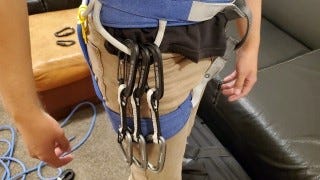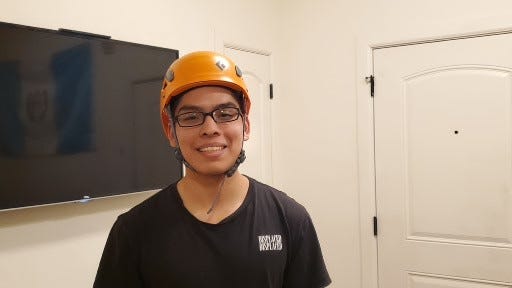Six gear you need before you start lead climbing
These six items will open the door to adventure for you.
As you begin to venture outdoors, you’ll need to know how to lead climb. Unlike your local climbing gym, there won’t be ropes hanging from the top of each route. But outdoor sport climbing routes do have bolts and with the right equipment you can secure yourself to the wall as you go. Assuming you already have shoes and a harness, here’s a list of the equipment you will need to safely and effectively lead climb.
Rope
This seems obvious, but it is worth noting that you need more than just ordinary rope. Your rope has to handle massive falls from climbers of various weights. Dynamic climbing rope is meant for this. This kind of lightweight rope stretches when a climber falls. The stretchiness allows the rope to absorb the shock so that the rope catches the climber with minimal wear and minimal impact on their body.
Dynamic climbing ropes can range from about $100 to $400 depending on the length and brand.
The length of the rope you get should depend on the height of the routes you plan to climb. A 60-meter rope will allow you to climb most single pitch sport routes. Always do your research ahead of time to learn how high the routes are at the crag you’re going to. Many routes will require 70-meter or even 80-meter ropes. Mountain Project is a great resource for that kind of information.
Quickdraws
A quickdraw is your best friend when climbing. With a rope clipped in properly and with good belaying, your quickdraw will keep you off the ground in the event of a fall. A quickdraw is basically a double-sided carabiner that you clip into the bolts along a sport route.
These typically cost about $10 to $15 a piece. How many you purchase, like your rope, also depends on the routes you plan to climb. Besides the number of bolts there are, you also want to carry at least two extras on any climb so you can clip into the chains or rings at the top of the wall.
Belay device
Rope and quickdraws mean nothing without a belay device that helps your partner secure the end of the rope, maintain friction and catch you if necessary. Lead belaying is a process of consistently giving and taking slack from the rope. A good belayer allows enough slack so the climber can move freely and clip the rope in efficiently but also keeps enough tension on the rope, so they are ready to brake at any given moment.
The most common belay devices used outdoors are the ATC, the ATC Pilot and the grigri. Compared to an ATC, many climbers prefer to their belayers to use the latter two because of their added layers of protection. These two belay devices are “assisted” meaning they have mechanisms that pinch the rope when it moves fast. So, should the belayer accidentally let their brake hand go (still not an excuse for a belayer to ever do this) the device should catch the climber.
Two belay devices are preferable so the climber can take one with them and rappel down from the top should they choose or need to. For this, it is best to use a grigri or an ATC.
ATCs cost about $20 while grigris are about a hundred. Pilots are in the middle costing about $40-$50.
Locking carabiners
Locking carabiners can serve a wide range of purposes in rock climbing. Most importantly, they are used for securing yourself to the top chains and/or creating anchors. Depending on the type of anchor you use, you may need as many as four. You will need at least one to secure your PAS.
Larger carabiners shaped like the one shown below are best for attaching belay devices to a harness. If you plan to rappel, bring an extra one with you.
These will typically range from $10 to $20.
Personal Anchor System (PAS)
Whether you’re setting up a top rope anchor or cleaning your route, you need a safe way to stay on the wall while you’re unattached from the rope (off belay). A PAS is your best bet. It is universally accepted as one of the safest devices for securing a climber to the top bolts or chains.
You can get one for $20-$30.
Helmet
It should go without saying, never climb without a helmet. And if you don’t want loose rock to ruin your day, get an extra one for your belayer, too.
You can find one for about $60.











